A Safe Infrastructure for Micromobility: The Current State of Knowledge
Abstract
:1. Introduction
1.1. Micromobility Characterization
1.1.1. Micromobility Devices
1.1.2. Criteria Affecting Safety on Bikelane
- (a)
- Bicycle lane: a bicycle path adjacent to a road, that can be in the same direction of motor vehicle circulation or a two-way lane (Figure 2a).
- (b)
- Protected bike track: a bike lane, physically separated from the road and sidewalk with lateral elements (Figure 2b).
- (c)
- (d)
- Bike track: a bike path with an independent layout that is completely segregated from motorized traffic (Figure 2f).
- (e)
- Cycle path: dedicated path for both pedestrians and cycles, segregated from traffic (Figure 2g).
1.2. Literature Review Studies on Micromobility
1.3. Objective
2. Methodology
- Geometry: curves (horizontal/vertical), lane width, low design speed, grading (lateral/longitudinal), lateral clearance, Stopping Sight Distance (SSD) and Overtaking Sight Distance (OSD), obstacle proximity, green space, drainage, and marking and signing.
- Pavement: skid resistance, vibration, distress.
- Traffic: mode choice, trip generation, distribution, volume, density, flow, and composition.
- Operating condition: crash frequency, crash severity, conflicts with pedestrians, conflicts with cars, weaving segments, overtaking lanes, passing proximity, v/c, operating speed, speed overrunning, acceleration/deceleration, presence of traffic light, steering and lean, lateral position/trajectory, presence of intersection, and connectivity.
3. Results
4. Discussion
4.1. Recommendations for Future Studies
4.2. Limitations of the Review Study
5. Conclusions
Author Contributions
Funding
Institutional Review Board Statement
Informed Consent Statement
Data Availability Statement
Conflicts of Interest
References
- Tiwari, A. Micro-Mobility: The Next Wave of Urban Transportation in India. 2019. Available online: https://www.linkedin.com/pulse/micro-mobility-next-wave-urban-transportation-india-abhishek-tiwari (accessed on 1 January 2023).
- Gomm, P.; Wengraf, I.; Hs, S. The Car and the Commute—The Journey to Work in England and Wales; RAC Foundation: London, UK, 2013. [Google Scholar]
- Kaufman, S.M.; Buttenwieser, L. The State of Scooter Sharing in United States Cities; Rudin Center for Transportation—New York University—Robert F. Wagner School for Public Service: New York, NY, USA, 2018. [Google Scholar]
- Clewlow, R. Urban Micromobility and Data for Planning and Policymaking. In Proceedings of the Fourth International Transport Energy Modeling Workshop, iTEM, Laxenburg, Austria, 30–31 October 2018. [Google Scholar]
- Møller, T.H.; Simlett, J.; Mugnier, E. Micromobility: Moving Cities into a Sustainable Future; EY: London, UK, 2020. [Google Scholar]
- Shaheen, S.; Cohen, A.; Chan, N.; Bansal, A. Sharing strategies: Carsharing, shared micromobility (bikesharing and scooter sharing), transportation network companies, microtransit, and other innovative mobility modes. In Transportation, Land Use, and Environmental Planning; Elsevier: Amsterdam, The Netherlands, 2020; pp. 237–262. [Google Scholar]
- Europeia, C. Livro Branco. Roteiro do espaço único europeu dos transportes—Rumo a um sistema de transportes competitivo e económico em recursos. Bruxelas 2011, 28, 2011. [Google Scholar]
- Wefering, F.; Rupprecht, S.; Bührmann, S.; Böhler-Baedeker, S. Guidelines. Developing and Implementing a Sustainable Urban Mobility Plan; Rupprecht Consult-Forschung und Beratung GmbH: Köln, Germany, 2013; p. 117. [Google Scholar]
- Rupprecht, S.; Brand, L.; Böhler-Baedeker, S.; Brunner, L.M. Guidelines for Developing and Implementing a Sustainable Urban Mobility Plan, 2nd ed.; European Platform on Sustainable Urban Mobility Plans; Rupprecht Consult-Forschung und Beratung GmbH: Köln, Germany, 2019. [Google Scholar]
- Schultheiss, B.; Goodman, D.; Blackburn, L.; Wood, A.; Reed, D.; Elbech, M. Bikeway Selection Guide; Federal Highway Administration—Office of Safety: Washington, DC, USA, 2019.
- Santacreu, A.; Yannis, G.; de Saint Leon, O.; Crist, P. Safe Micromobility; The International Transport Forum: Paris, France, 2020.
- De Valencia, A. Ordenanza de Movilidad. Available online: https://sede.valencia.es/sede/descarga/doc/DOCUMENT_1_ORD0095_C (accessed on 1 January 2023).
- NTSB. Bicyclist Safety on US Roadways Risks and Countermeasures; US National Transportation Safety Board: Washington, DC, USA, 2019.
- NACTO. Urban Bikeway Design Guide; Island Press: Washington, DC, USA, 2014; ISBN 1-61091-565-8. [Google Scholar]
- Sánchez, D.F.D.G. Real Decreto Legislativo 6/2015, de 30 de octubre, por el que se aprueba el texto refundido de la Ley sobre Tráfico, Circulación de Vehículos a Motor y Seguridad Vial [BOE No. 261, 31-X-2015]. AIS Ars Iuris Salmant. 2016, 4, 232–233. [Google Scholar]
- Street View Valencian Community 2015. Google Maps, April 2015. Available online: https://www.google.com/maps/@39.4795164,-0.3431766,3a,75y,251.81h,79.95t/data=!3m6!1e1!3m4!1spT1xwn_UDy_Khbx8jgwFWg!2e0!7i13312!8i6656 (accessed on 30 December 2022).
- Street View 54 Hoskin Ave, Toronto 2021. Google Maps, June 2021. Available online: https://www.google.com/maps/@43.6641362,-79.398149,3a,75y,218.13h,61.33t/data=!3m6!1e1!3m4!1sQyz5SR3r_04M7RZHqWPvUQ!2e0!7i16384!8i8192!5m1!1e2 (accessed on 30 December 2022).
- Greibe, P.; Buch, T.S. Capacity and behaviour on one-way cycle tracks of different widths. Transp. Res. Procedia 2016, 15, 122–136. [Google Scholar] [CrossRef] [Green Version]
- Park, J.; Abdel-Aty, M. Evaluation of safety effectiveness of multiple cross sectional features on urban arterials. Accid. Anal. Prev. 2016, 92, 245–255. [Google Scholar] [CrossRef] [PubMed]
- Ma, Q.; Yang, H.; Mayhue, A.; Sun, Y.; Huang, Z.; Ma, Y. E-Scooter safety: The riding risk analysis based on mobile sensing data. Accid. Anal. Prev. 2021, 151, 105954. [Google Scholar] [CrossRef]
- López-Molina, M.; Llopis-Castelló, D.; Pérez-Zuriaga, A.M.; Alonso-Troyano, C.; García, A. Skid Resistance Analysis of Urban Bike Lane Pavements for Safe Micromobility. Sustainability 2023, 15, 698. [Google Scholar] [CrossRef]
- Cafiso, S.; Di Graziano, A.; Marchetta, V.; Pappalardo, G. Urban road pavements monitoring and assessment using bike and e-scooter as probe vehicles. Case Stud. Constr. Mater. 2022, 16, e00889. [Google Scholar] [CrossRef]
- Wyman, A. A Safety Evaluation of Turn Lane-Adjacent Bike Lane Configurations in Portland, Oregon. Master’s Thesis, Oregon State University, Corvallis, OR, USA, 2022. [Google Scholar]
- Pérez-Zuriaga, A.M.; Llopis-Castelló, D.; Just-Martínez, V.; Fonseca-Cabrera, A.S.; Alonso-Troyano, C.; García, A. Implementation of a Low-Cost Data Acquisition System on an E-Scooter for Micromobility Research. Sensors 2022, 22, 8215. [Google Scholar] [CrossRef]
- Tian, D.; Ryan, A.D.; Craig, C.M.; Sievert, K.; Morris, N.L. Characteristics and Risk Factors for Electric Scooter-Related Crashes and Injury Crashes among Scooter Riders: A Two-Phase Survey Study. Int. J. Environ. Res. Public. Health 2022, 19, 10129. [Google Scholar] [CrossRef]
- Prencipe, L.P.; Colovic, A.; De Bartolomeo, S.; Caggiani, L.; Ottomanelli, M. An efficiency indicator for micromobility safety assessment. In Proceedings of the 2022 IEEE International Conference on Environment and Electrical Engineering and 2022 IEEE Industrial and Commercial Power Systems Europe (EEEIC/I&CPS Europe), Prague, Czech Republic, 28 June–1 July 2022; IEEE: Piscataway, NJ, USA, 2022; pp. 1–6. [Google Scholar]
- Dozza, M.; Li, T.; Billstein, L.; Svernlöv, C.; Rasch, A. How do different micro-mobility vehicles affect longitudinal control? Results from a field experiment. J. Saf. Res. 2022, 84, 24–32. [Google Scholar] [CrossRef]
- Folco, P.; Gauvin, L.; Tizzoni, M.; Szell, M. Data-driven micromobility network planning for demand and safety. Environ. Plan. B Urban Anal. City Sci. 2022, 23998083221135612. [Google Scholar] [CrossRef]
- Clewlow, R.; Foti, F.; Seki, S.; Mueting, E. Developing Scalable Models for Safety Insights and Improvements Using E-Scooter Exposure Data; The U.S. Department of Transportation (DOT): Washington, DC, USA, 2022.
- Anke, J.; Ringhand, M.; Petzoldt, T.; Gehlert, T. Micro-Mobility and Road Safety—Why Do E-Scooter Riders Use the Sidewalk? SSRN 2022, 4239363. [Google Scholar] [CrossRef]
- Gehrke, S.R.; Russo, B.J.; Sadeghinasr, B.; Riffle, K.R.; Smaglik, E.J.; Reardon, T.G. Spatial interactions of shared e-scooter trip generation and vulnerable road user crash frequency. J. Transp. Saf. Secur. 2022, 14, 1798–1814. [Google Scholar] [CrossRef]
- Chang, F.; Haque, M.M.; Yasmin, S.; Huang, H. Crash injury severity analysis of E-Bike Riders: A random parameters generalized ordered probit model with heterogeneity in means. Saf. Sci. 2022, 146, 105545. [Google Scholar] [CrossRef]
- Fonseca-Cabrera, A.S.; Llopis-Castelló, D.; Pérez-Zuriaga, A.M.; Alonso-Troyano, C.; García, A. Micromobility Users’ Behaviour and Perceived Risk during Meeting Manoeuvres. Int. J. Environ. Res. Public. Health 2021, 18, 12465. [Google Scholar] [CrossRef]
- Zuniga-Garcia, N.; Juri, N.R.; Perrine, K.A.; Machemehl, R.B. E-scooters in urban infrastructure: Understanding sidewalk, bike lane, and roadway usage from trajectory data. Case Stud. Transp. Policy 2021, 9, 983–994. [Google Scholar] [CrossRef]
- Hosseinzadeh, A.; Algomaiah, M.; Kluger, R.; Li, Z. E-Scooters and Sustainability: Investigating the Relationship between the Density of E-Scooter Trips and Characteristics of Sustainable Urban Development. Sustain. Cities Soc. 2021, 66, 102624. [Google Scholar] [CrossRef]
- Hawa, L.; Cui, B.; Sun, L.; El-Geneidy, A. Scoot over: Determinants of Shared Electric Scooter Presence in Washington DC. Case Stud. Transp. Policy 2021, 9, 418–430. [Google Scholar] [CrossRef]
- Kamel, M.B.; Sayed, T. The Impact of Bike Network Indicators on Bike Kilometers Traveled and Bike Safety: A Network Theory Approach. Environ. Plan. B Urban Anal. City Sci. 2021, 48, 2055–2072. [Google Scholar] [CrossRef]
- Tan, S.; Tamminga, K. A Vision for Urban Micromobility. In Proceedings of the Conference on Sustainable Urban Mobility, Skiathos Island, Greece, 17–19 June 2020; Springer: Berlin/Heidelberg, Germany, 2020; pp. 158–167. [Google Scholar]
- Tomiyama, K.; Moriishi, K. Pavement Surface Evaluation Interacting Vibration Characteristics of an Electric Mobility Scooter. In Proceedings of the 9th International Conference on Maintenance and Rehabilitation of Pavements—Mairepav9, Zurich, Switzerland, 1–3 July 2020; Springer: Berlin/Heidelberg, Germany, 2020; pp. 893–900. [Google Scholar]
- Carrignon, D. Connected and autonomous vehicles, electric scooter and their implications for road network design. Transp. Res. Procedia 2020, 49, 160–169. [Google Scholar] [CrossRef]
- Gössling, S. Integrating e-scooters in urban transportation: Problems, policies, and the prospect of system change. Transp. Res. Part Transp. Environ. 2020, 79, 102230. [Google Scholar] [CrossRef]
- He, S.; Shin, K.G. Dynamic Flow Distribution Prediction for Urban Dockless E-Scooter Sharing Reconfiguration. In Proceedings of the Web Conference 2020, Taipei, Taiwan, 20–24 April 2020; pp. 133–143. [Google Scholar]
- Zou, Z.; Younes, H.; Erdoğan, S.; Wu, J. Exploratory analysis of real-time e-scooter trip data in Washington, DC. Transp. Res. Rec. 2020, 2674, 285–299. [Google Scholar] [CrossRef]
- Almannaa, M.H.; Ashqar, H.I.; Elhenawy, M.; Masoud, M.; Rakotonirainy, A.; Rakha, H. A Comparative Analysis of E-Scooter and e-Bike Usage Patterns: Findings from the City of Austin, TX. Int. J. Sustain. Transp. 2021, 15, 571–579. [Google Scholar] [CrossRef]
- Caspi, O.; Smart, M.J.; Noland, R.B. Spatial associations of dockless shared e-scooter usage. Transp. Res. Part Transp. Environ. 2020, 86, 102396. [Google Scholar] [CrossRef] [PubMed]
- Jiao, J.; Bai, S. Understanding the shared e-scooter travels in Austin, TX. ISPRS Int. J. Geo-Inf. 2020, 9, 135. [Google Scholar] [CrossRef] [Green Version]
- Yang, H.; Ma, Q.; Wang, Z.; Cai, Q.; Xie, K.; Yang, D. Safety of micro-mobility: Analysis of E-Scooter crashes by mining news reports. Accid. Anal. Prev. 2020, 143, 105608. [Google Scholar] [CrossRef]
- Bai, S.; Jiao, J. Dockless E-scooter usage patterns and urban built Environments: A comparison study of Austin, TX, and Minneapolis, MN. Travel Behav. Soc. 2020, 20, 264–272. [Google Scholar] [CrossRef]
- Lazarus, J.; Pourquier, J.C.; Feng, F.; Hammel, H.; Shaheen, S. Micromobility evolution and expansion: Understanding how docked and dockless bikesharing models complement and compete—A case study of San Francisco. J. Transp. Geogr. 2020, 84, 102620. [Google Scholar] [CrossRef]
- Politis, I.; Papadopoulos, E.; Fyrogenis, I.; Fytsili, Z. A Multi-Criteria-Based Methodology for Assessing Alternative Bicycle Lane Implementation Solutions in Urban Networks. In Proceedings of the Conference on Sustainable Urban Mobility, Skiathos Island, Greece, 17–19 June 2020; Springer: Cham, Switzerland, 2020; pp. 435–444. [Google Scholar]
- Wang, K.; Chen, Y.-J. Joint Analysis of the Impacts of Built Environment on Bikeshare Station Capacity and Trip Attractions. J. Transp. Geogr. 2020, 82, 102603. [Google Scholar] [CrossRef]
- Hu, L.; Hu, X.; Wang, J.; Kuang, A.; Hao, W.; Lin, M. Casualty Risk of E-Bike Rider Struck by Passenger Vehicle Using China in-Depth Accident Data. Traffic Inj. Prev. 2020, 21, 283–287. [Google Scholar] [CrossRef]
- Xing, Y.; Wang, K.; Lu, J.J. Exploring Travel Patterns and Trip Purposes of Dockless Bike-Sharing by Analyzing Massive Bike-Sharing Data in Shanghai, China. J. Transp. Geogr. 2020, 87, 102787. [Google Scholar] [CrossRef]
- AASHTO (“Green Book”). A Policy on Geometric Design of Highways and Streets; AASHTO (“Green Book”): Washington, DC, USA, 2011. [Google Scholar]
- McKenzie, G. Spatiotemporal comparative analysis of scooter-share and bike-share usage patterns in Washington, DC. J. Transp. Geogr. 2019, 78, 19–28. [Google Scholar] [CrossRef]
- Voinov, A.; Morales, J.; Hogenkamp, H. Analyzing the social impacts of scooters with geo-spatial methods. J. Environ. Manag. 2019, 242, 529–538. [Google Scholar] [CrossRef]
- Chang, A.Y.; Miranda-Moreno, L.; Clewlow, R.; Sun, L. Trend or Fad. Deciphering Enablers Micromobility US 2019. [Google Scholar]
- Du, Y.; Deng, F.; Liao, F. A Model Framework for Discovering the Spatio-Temporal Usage Patterns of Public Free-Floating Bike-Sharing System. Transp. Res. Part C Emerg. Technol. 2019, 103, 39–55. [Google Scholar] [CrossRef]
- He, Y.; Song, Z.; Liu, Z.; Sze, N.N. Factors influencing electric bike share ridership: Analysis of Park City, Utah. Transp. Res. Rec. 2019, 2673, 12–22. [Google Scholar] [CrossRef]
- Guo, Y.; Wu, Y.; Lu, J.; Zhou, J. Modeling the Unobserved Heterogeneity in E-Bike Collision Severity Using Full Bayesian Random Parameters Multinomial Logit Regression. Sustainability 2019, 11, 2071. [Google Scholar] [CrossRef] [Green Version]
- Zhang, Y.; Lin, D.; Liu, X.C. Biking Islands in Cities: An Analysis Combining Bike Trajectory and Percolation Theory. J. Transp. Geogr. 2019, 80, 102497. [Google Scholar] [CrossRef]
- Xu, C.; Yu, X. Modeling and Analysis of Crash Severity for Electric Bicycle. In Proceedings of the International Conference on Intelligent Interactive Multimedia Systems and Services, Gold Coast, Australia, 20–22 June 2018; Springer: Cham, Switzerland, 2018; pp. 367–375. [Google Scholar]
- Smith, C.S.; Schwieterman, J.P. E-Scooter Scenarios: Evaluating the Potential Mobility Benefits of Shared Dockless Scooters in Chicago; Chaddick Institute for Metropolitan Development: Chicago, IL, USA, 2018. [Google Scholar]
- Wang, T.; Chen, J.; Wang, C.; Ye, X. Understand e-bicyclist safety in China: Crash severity modeling using a generalized ordered logit model. Adv. Mech. Eng. 2018, 10, 6. [Google Scholar] [CrossRef] [Green Version]
- Zhang, X.; Yang, Y.; Yang, J.; Hu, J.; Li, Y.; Wu, M.; Stallones, L.; Xiang, H. Road Traffic Injuries among Riders of Electric Bike/Electric Moped in Southern China. Traffic Inj. Prev. 2018, 19, 417–422. [Google Scholar] [CrossRef]
- Zhang, Y.; Brussel, M.J.; Thomas, T.; van Maarseveen, M.F. Mining Bike-Sharing Travel Behavior Data: An Investigation into Trip Chains and Transition Activities. Comput. Environ. Urban Syst. 2018, 69, 39–50. [Google Scholar] [CrossRef]
- Yuan, Q.; Yang, H.; Huang, J.; Kou, S.; Li, Y.; Theofilatos, A. What Factors Impact Injury Severity of Vehicle to Electric Bike Crashes in China? Adv. Mech. Eng. 2017, 9, 1687814017700546. [Google Scholar] [CrossRef] [Green Version]
- Xu, J.; Shang, S.; Qi, H.; Yu, G.; Wang, Y.; Chen, P. Simulative investigation on head injuries of electric self-balancing scooter riders subject to ground impact. Accid. Anal. Prev. 2016, 89, 128–141. [Google Scholar] [CrossRef]
- Xu, J.; Shang, S.; Yu, G.; Qi, H.; Wang, Y.; Xu, S. Are electric self-balancing scooters safe in vehicle crash accidents? Accid. Anal. Prev. 2016, 87, 102–116. [Google Scholar] [CrossRef] [PubMed]
- Bordagaray, M.; Dell’Olio, L.; Fonzone, A.; Ibeas, Á. Capturing the Conditions That Introduce Systematic Variation in Bike-Sharing Travel Behavior Using Data Mining Techniques. Transp. Res. Part C Emerg. Technol. 2016, 71, 231–248. [Google Scholar] [CrossRef]
- Garcia, A.; Gomez, F.A.; Llorca, C.; Angel-Domenech, A. Effect of width and boundary conditions on meeting maneuvers on two-way separated cycle tracks. Accid. Anal. Prev. 2015, 78, 127–137. [Google Scholar] [CrossRef]
- Corcoran, J.; Li, T.; Rohde, D.; Charles-Edwards, E.; Mateo-Babiano, D. Spatio-Temporal Patterns of a Public Bicycle Sharing Program: The Effect of Weather and Calendar Events. J. Transp. Geogr. 2014, 41, 292–305. [Google Scholar] [CrossRef]
- Ohri, V. Developing Test Methods for the Evaluation of Scooter Performance in Winter Conditions. Ph.D. Thesis, University of Toronto, Toronto, ON, Canada, 2013. [Google Scholar]
- Blackman, R.A.; Haworth, N.L. Comparison of moped, scooter and motorcycle crash risk and crash severity. Accid. Anal. Prev. 2013, 57, 1–9. [Google Scholar] [CrossRef] [Green Version]
- Montella, A.; Aria, M.; D’Ambrosio, A.; Mauriello, F. Analysis of powered two-wheeler crashes in Italy by classification trees and rules discovery. Accid. Anal. Prev. 2012, 49, 58–72. [Google Scholar] [CrossRef]
- Dondi, G.; Simone, A.; Lantieri, C.; Vignali, V. Bike lane design: The context sensitive approach. Procedia Eng. 2011, 21, 897–906. [Google Scholar] [CrossRef] [Green Version]
- Marshall, W.E.; Garrick, N.W. Does street network design affect traffic safety? Accid. Anal. Prev. 2011, 43, 769–781. [Google Scholar] [CrossRef] [PubMed]
- Oeschager, G.; Carroll, P.; Caulfield, B. Micromobility and public transport integration: The current state of knowledge. Transp. Res. Part Transp. Environ. 2020, 89, 102628. [Google Scholar] [CrossRef]
- Yan, X.; Yang, W.; Zhang, X.; Xu, Y.; Bejleri, I.; Zhao, X. A spatiotemporal analysis of e-scooters’ relationships with transit and station-based bikeshare. Transp. Res. Part Transp. Environ. 2021, 101, 103088. [Google Scholar] [CrossRef]
- Deveci, M.; Gokasar, I.; Pamucar, D.; Chen, Y.; Coffman, D. Sustainable E-scooter parking operation in urban areas using fuzzy Dombi based RAFSI model. Sustain. Cities Soc. 2023, 91, 104426. [Google Scholar] [CrossRef]
- Nigro, M.; Castiglione, M.; Colasanti, F.M.; De Vincentis, R.; Valenti, G.; Liberto, C.; Comi, A. Exploiting floating car data to derive the shifting potential to electric micromobility. Transp. Res. Part Policy Pract. 2022, 157, 78–93. [Google Scholar] [CrossRef]
- Abduljabbar, R.L.; Liyanage, S.; Dia, H. The role of micro-mobility in shaping sustainable cities: A systematic literature review. Transp. Res. Part Transp. Environ. 2021, 92, 102734. [Google Scholar] [CrossRef]
- Şengül, B.; Mostofi, H. Impacts of E-Micromobility on the sustainability of urban transportation—A systematic review. Appl. Sci. 2021, 11, 5851. [Google Scholar] [CrossRef]
- Liao, F.; Correia, G. Electric carsharing and micromobility: A literature review on their usage pattern, demand, and potential impacts. Int. J. Sustain. Transp. 2022, 16, 269–286. [Google Scholar] [CrossRef]
- Elmashhara, M.G.; Silva, J.; Sá, E.; Carvalho, A.; Rezazadeh, A. Factors influencing user behaviour in micromobility sharing systems: A systematic literature review and research directions. Travel Behav. Soc. 2022, 27, 1–25. [Google Scholar] [CrossRef]
- Kaths, H. Cyclists’ interactions with other road users from a safety perspective. Cycling 2022, 187. [Google Scholar]
- Sandt, L.; West, A.; Harmon, K.J.; Bryson, M.; Gelinne, D.; Cherry, C.R.; Sexton, E.; Shah, N.; Sanders, R.; Brown, C.T. E-Scooter Safety: Issues and Solutions; Transportation Research Board: Washington, DC, USA, 2022. [Google Scholar]
- O’Hern, S.; Estgfaeller, N. A scientometric review of powered micromobility. Sustainability 2020, 12, 9505. [Google Scholar] [CrossRef]
- Thomas, J.; Harden, A. Methods for the thematic synthesis of qualitative research in systematic reviews. BMC Med. Res. Methodol. 2008, 8, 1. [Google Scholar] [CrossRef] [PubMed] [Green Version]

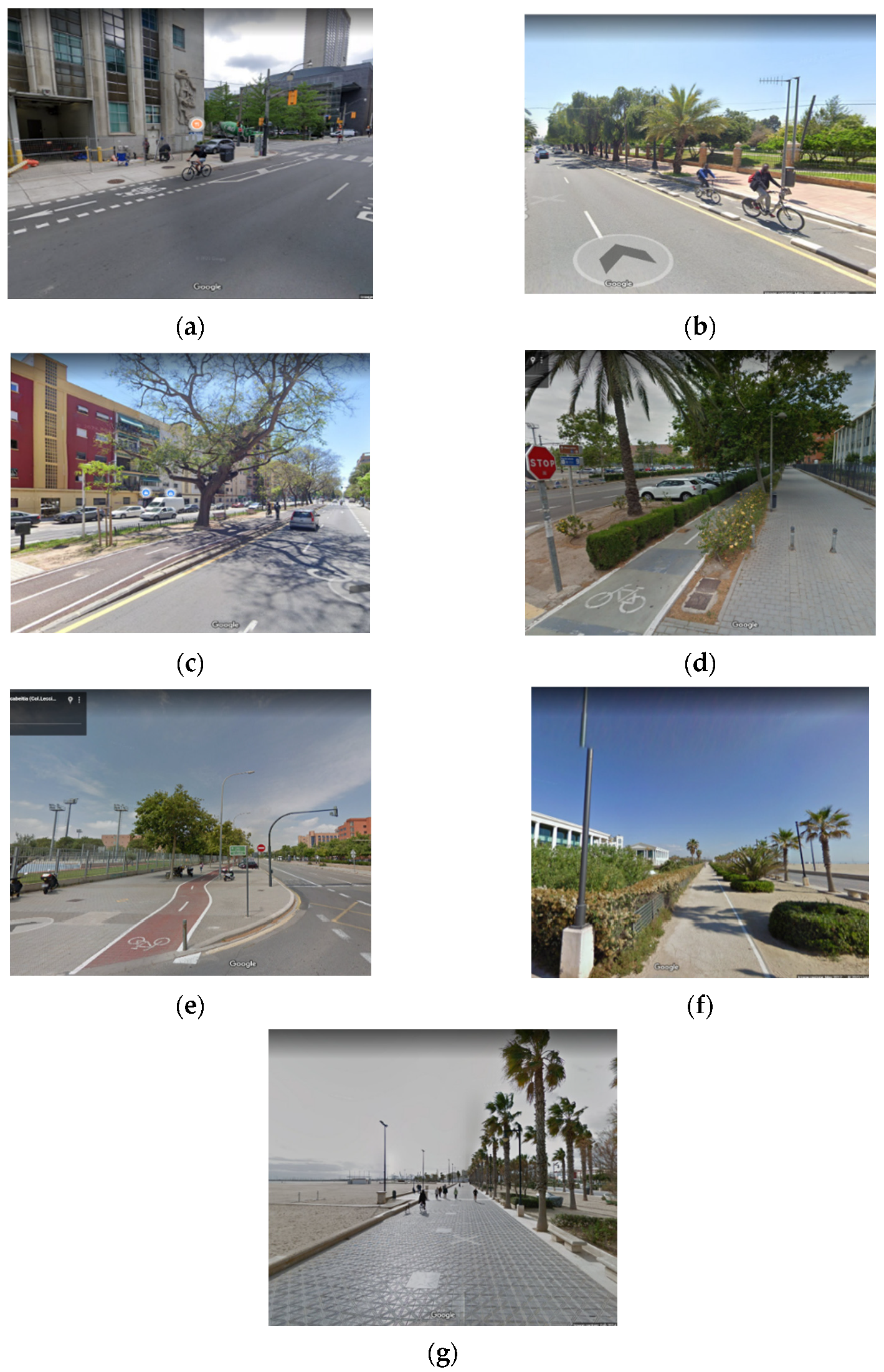
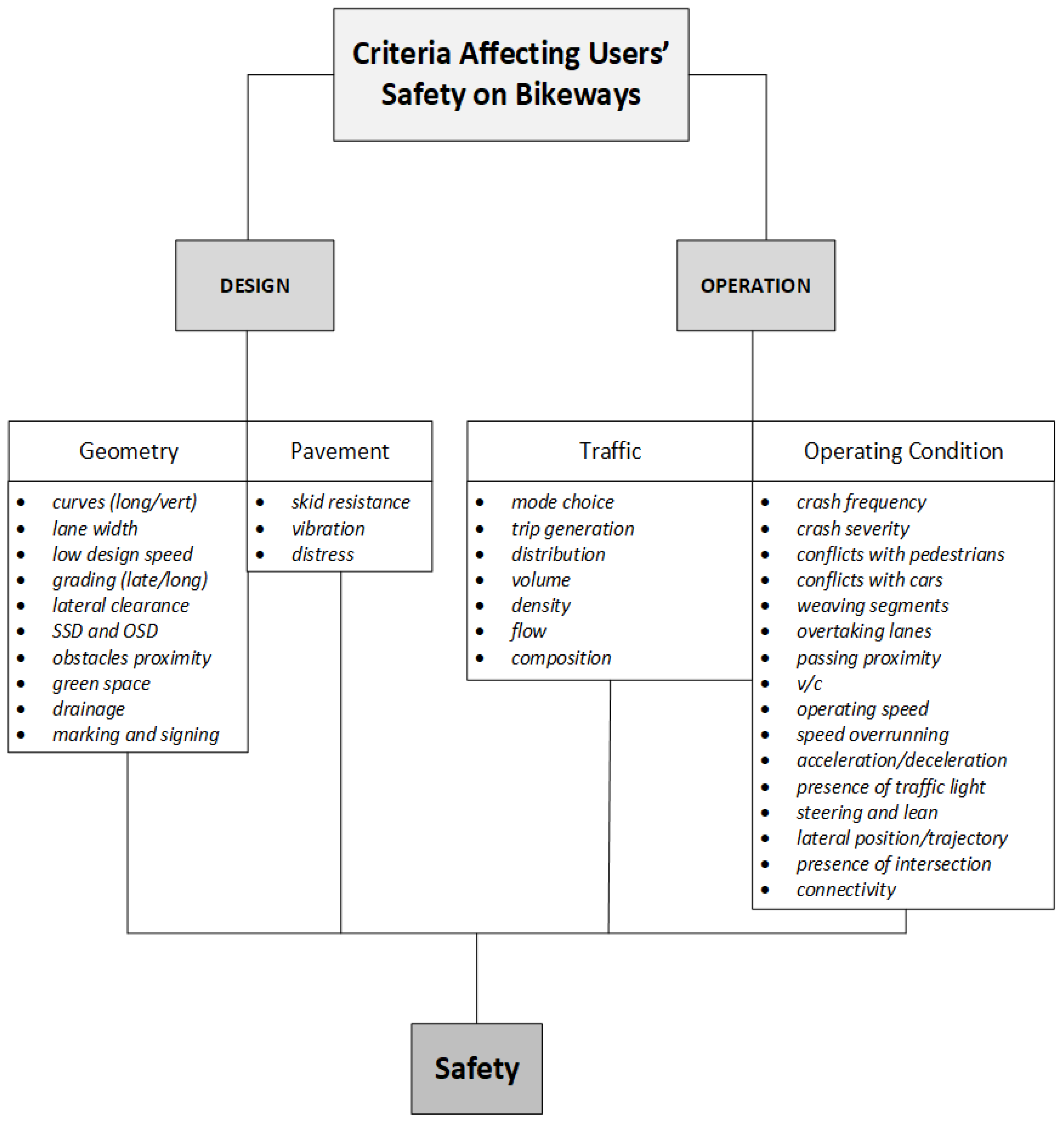

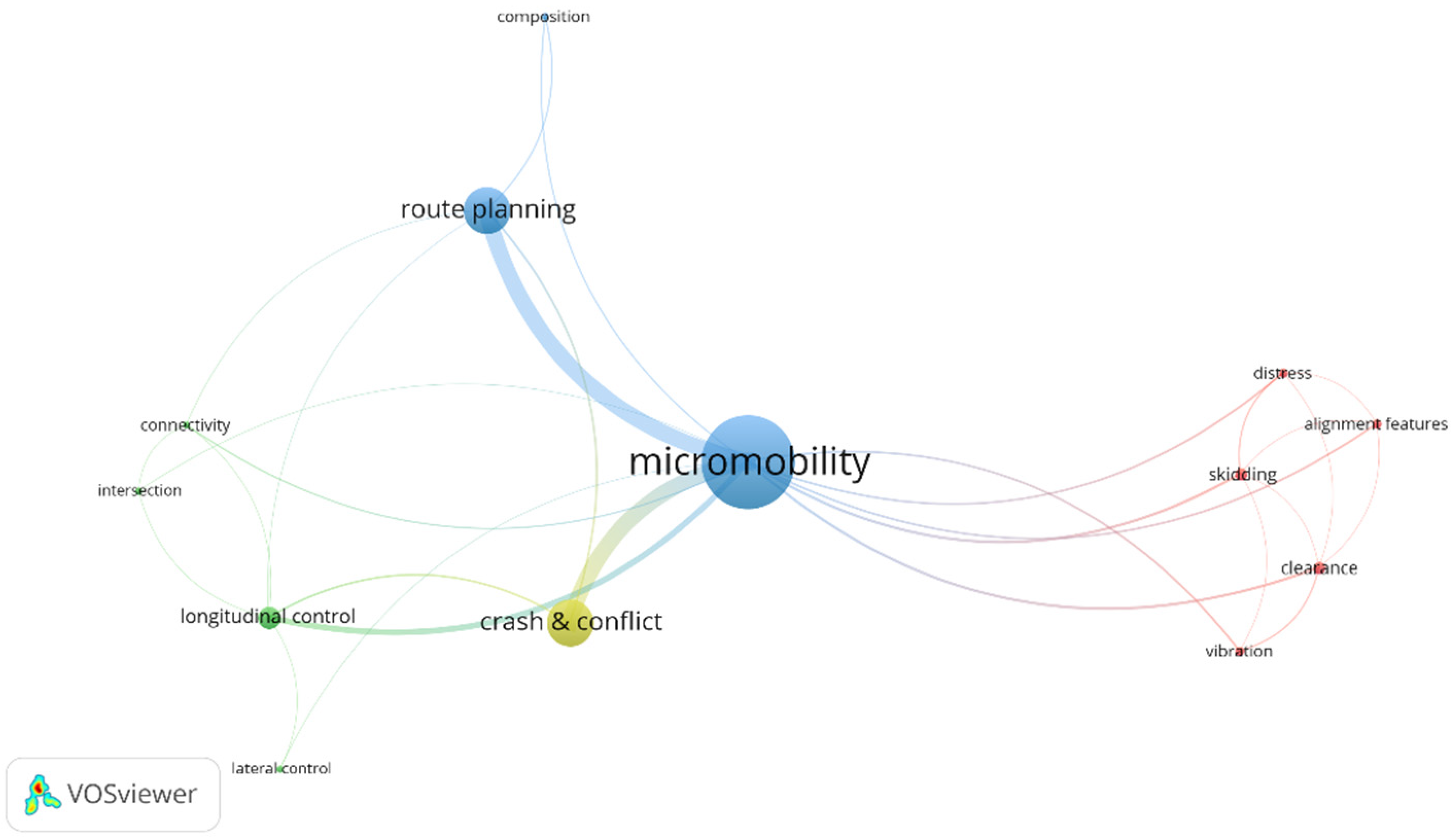


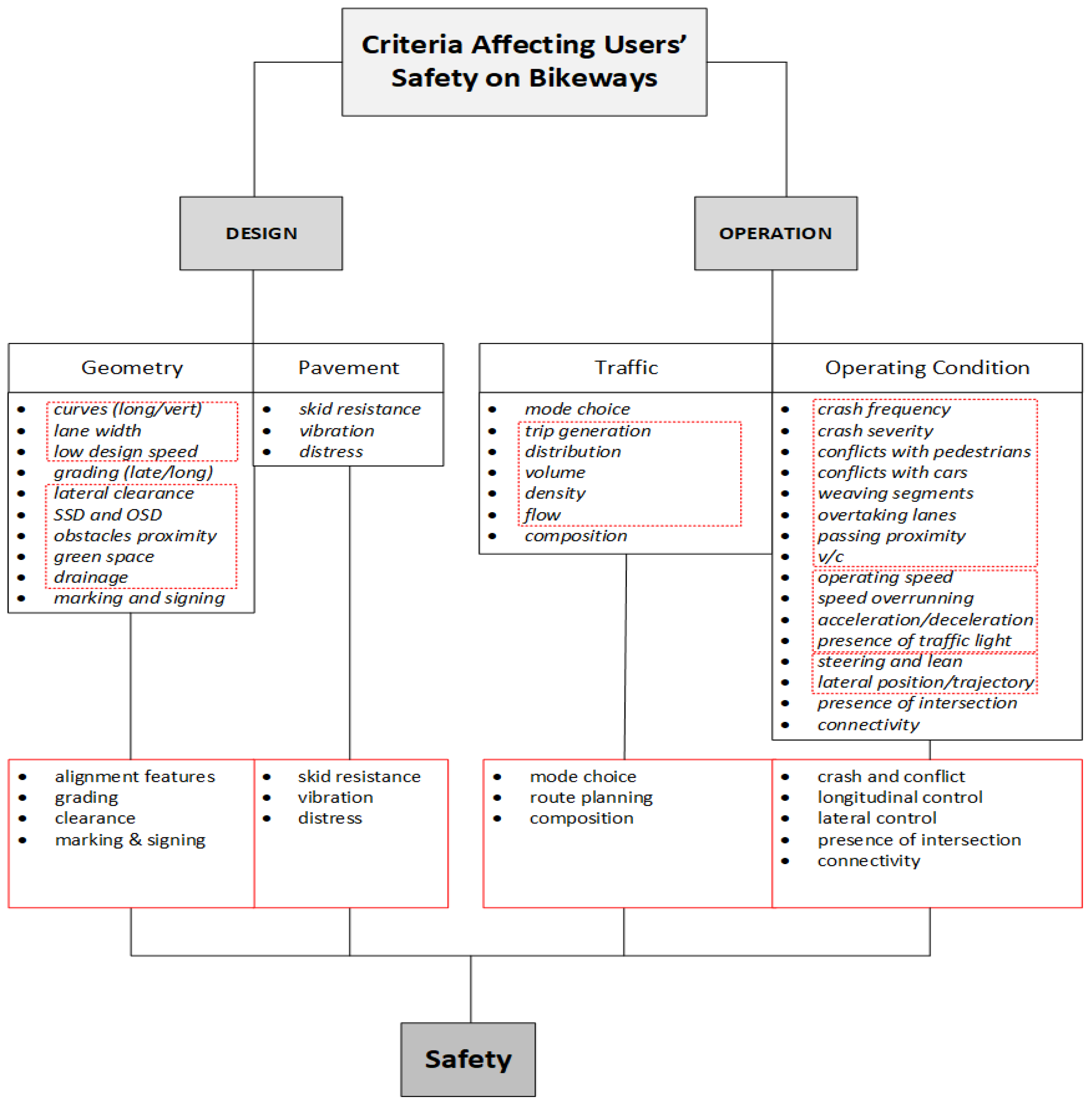
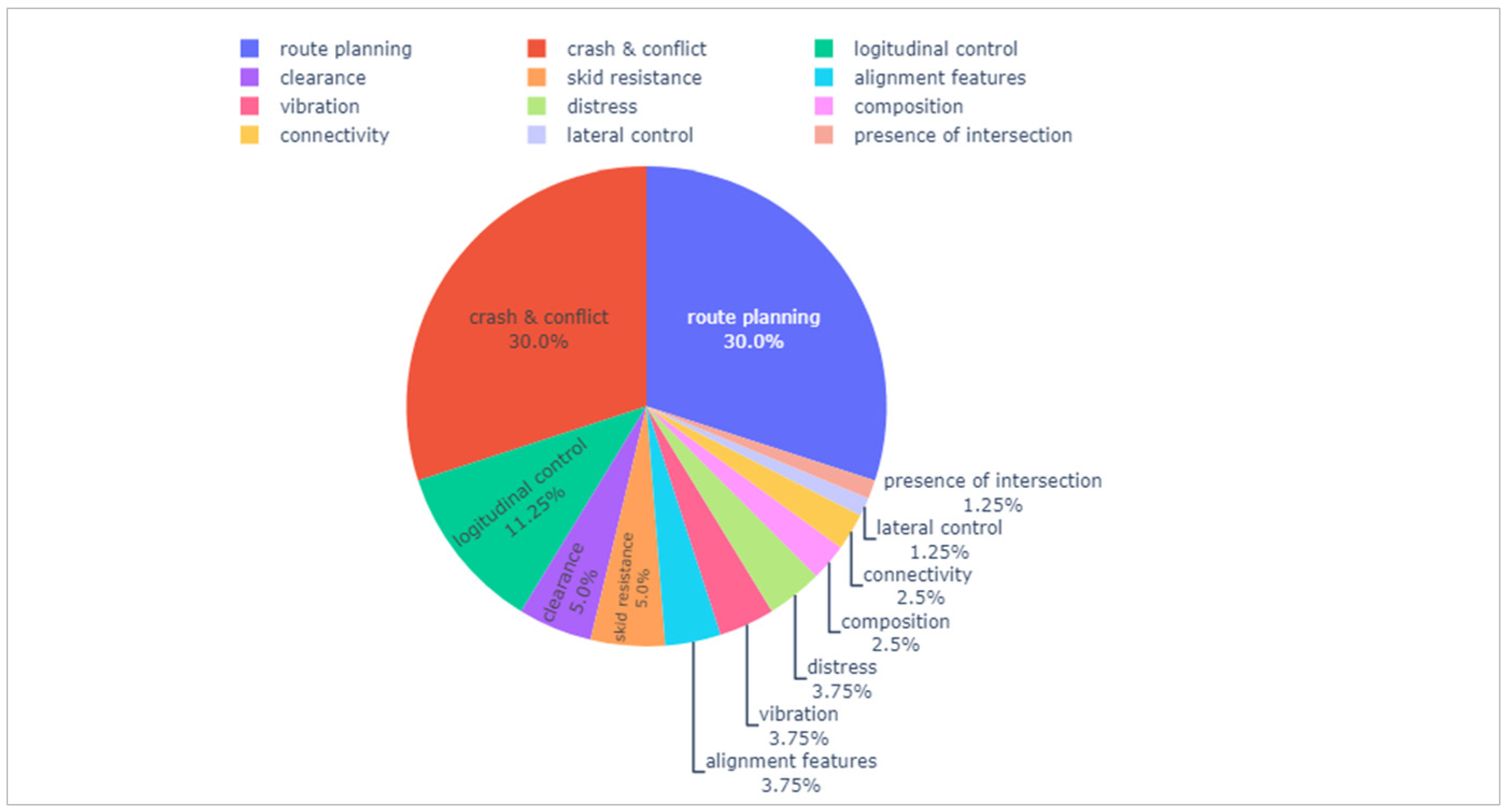
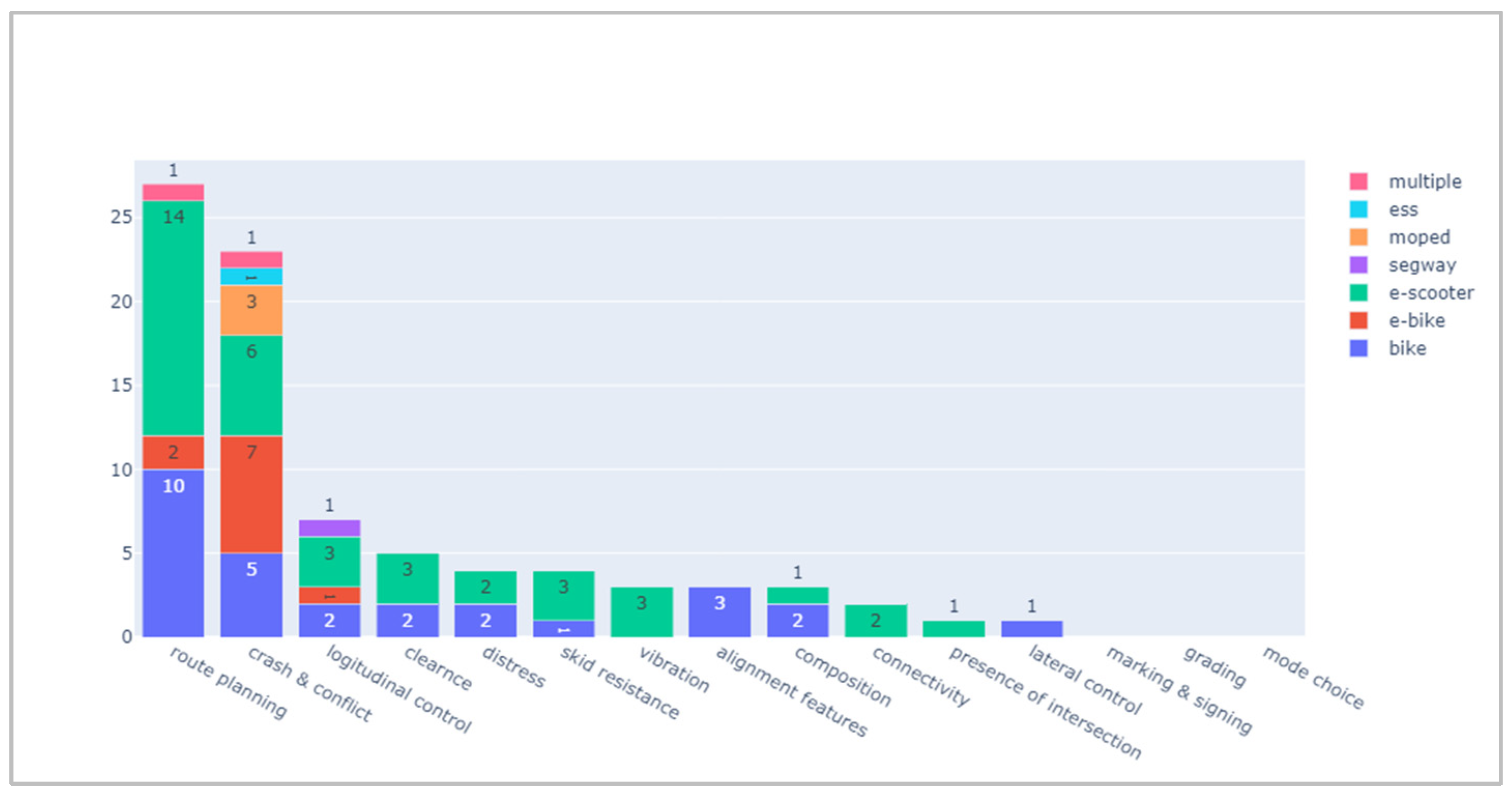

| # | Researcher/Year | Criteria | Sub-Criteria | MD Modes | Sample Size & Location |
|---|---|---|---|---|---|
| 1 | Wyman [23] (2022) | operating condition | crash & conflict | bike | 300 h of video recording at 5 bike lanes (Portland, OR, USA) |
| 2 | M. Pérez-Zuriaga [24] (2022) | pavement, geometry | vibration, clearance | e-scooter | 850 m of bike lane (Valencia, Spain) |
| 3 | Tian et al. [25] (2022) | operating condition | crash & conflict | e-scooter | worldwide (social media data) |
| 4 | Prencipe et al. [26] (2022) | operating condition | intersection, long.control, connectivity | e-scooter | 336 buffers (Bari, Italy) |
| 5 | Dozza et al. [27] (2022) | operating condition | longitudinal control | e-scooter, segway, e-bike, bike | 34 participants (Chalmers, Sweden) |
| 6 | Folco et al. [28] (2022) | traffic, operating condition | route planning, crash & conflict | bike, e-scooter | 314 crashes in 2019, 40,694 trips (Turin, Italy) |
| 7 | Clewlow et al. [29] (2022) | traffic, operating condition | route planning, crash & conflict | e-scooter | 22,022 crash data from 2014–2021 (4 cities, USA) |
| 8 | Anke et al. [30] (2022) | traffic, operating condition | route planning, connectivity | e-scooter | six sites/738 recording (Dresden & Berlin, Germany) |
| 9 | Gehrke et al. [31] (2022) | traffic, operating condition | route planning, crash & conflict | e-scooter | eight months (Brookline, MA, USA) |
| 10 | Cafiso et al. [22] (2022) | pavement | distress | bike, e-scooter | 979 tests (Italy) |
| 11 | Chang F et al. [32] (2022) | operating condition | crash & conflict | e-bike | 2222 crash records from 2014 to 2016 (Hunan, China) |
| 12 | Fonseca-Cabrera [33] (2021) | geometry | clearance | bike, e-scooter | 80 km bicycle tracks/25 h video (Valencia, Spain) |
| 13 | Ma Q [20] (2021) | pavement, geometry | vibration, clearance | e-scooter | One road segment—vehicle lane & sidewalk (Norfolk, VA, USA) |
| 14 | Zuniga-Garcia N. et al. [34] (2021) | traffic | route planning | e-scooter | 80,000 trips/11 million location points (Austin, TX, USA) |
| 15 | Hosseinzadeh A [35] (2021) | traffic | route planning | e-scooter | 494,008 trips/159 route planning analysis zone (Louisville, KY, USA) |
| 16 | Hawa L et al. [36] (2021) | traffic | route planning | e-scooter | 1671 geographic grid cells of 0.19 km2 (Washington, DC, USA) |
| 17 | Ma Q [20] (2021) | operating condition | longitudinal control | e-scooter | NA |
| 18 | Bayoumi Kamel M & Sayed T [37] (2021) | operating condition | crash & conflict | bike | NA |
| 19 | Tan S. et al. [38] (2020) | operating condition | crash & conflict | multiple | 1 case study (Washington, DC, USA) |
| 20 | Tomiyama K and Moriishi K [39] (2020) | pavement | vibration, skidding | e-scooter | 10 different surfaces—grading &roughness (Saitama, Japan) |
| 21 | Carrignon D [40] (2020) | pavement | skidding, distress | e-scooter | Synthesis of literature (France & UK) |
| 22 | Gössling S. [41] (2020) | operating condition | crash & conflict, longitudinal control | e-scooter | 173 news items (10 cities *) |
| 23 | He and Shin [42] (2020) | traffic | route planning | e-scooter | 2,430,806 trips (Austin, TX, USA) |
| 24 | Zou et al. [43] (2020) | traffic | route planning | e-scooter | 138,362 trips (Washington, DC, USA) |
| 25 | Almannaa et al. [44] (2020) | operating condition | longitudinal control | e-scooter | 15,400 E-Scooters (Austin, TX, USA) |
| 26 | Caspi et al. [45] (2020) | traffic | route planning | e-scooter | 11,358 trips per day (Austin, TX, USA) |
| 27 | Jiao and Bai [46] (2020) | traffic | route planning | e-scooter | 158,208 trips per month (Austin, TX, USA) |
| 28 | Yang et al. [47] (2020) | operating condition | crash & conflict | e-scooter | 169 news on E-Scooter-involved crashes |
| 29 | Bai and Jiao [48] (2020) | traffic | route planning | e-scooter | 661,367 & 225,543 trips/month (Austin, TX, USA, Minneapolis, MN, USA) |
| 30 | Lazarus et al. [49] (2020) | traffic | route planning | bike, e-bike (shared) | 124,980 trips per month (San Francisco, CA, USA) |
| 31 | Politis et al. [50] (2020) | operating condition | crash & conflict | bike | 2 one-way & 1 two-way bike lane (Karditsa, Greece) |
| 32 | Wang K and Chen J [51] (2020) | traffic | route planning | bike (shared) | 430,560 trips in September 2016 (New York, DC, USA) |
| 33 | Hu L et al. [52] (2020) | operating condition | crash & conflict, longitudinal control | e-bike | 219 accidents—2014 to 2016 (6 cities, China) |
| 34 | Xing et al. [53] (2020) | traffic | route planning | bike (shared) | 1,023,603 trips in August 2016 -Mobike (Shanghai, China) |
| 35 | AASHTO [54] (2019) | operating condition | crash & conflict | e-scooter | 271 E-Scooter-related injuries (Austin, TX, USA) |
| 36 | McKenzie G [55] (2019) | traffic | route planning, composition | bike, e-scooter | 1,414,055 bike & 937,590 e-scooter trips (Washington, DC, USA) |
| 37 | Voinov et al. [56] (2019) | operating condition | crash & conflict | scooter | 10,811 scooter owners (Enschede Netherlands) |
| 38 | Chang et al. [57] (2019) | traffic, operating condition | route planning, longitudinal control | multiple | Synthesis of literature (Washington, DC, USA) |
| 39 | Du Y et al. [58] (2019) | traffic | route planning | bike | 830,000 trips in September 2016 (Shanghai, China) |
| 40 | He Y et al. [59] (2019) | traffic | route planning | e-bike (shared) | 7921 trips in 107 days-20 July to 3 November 2017 (Park City, UT, USA) |
| 41 | Guo Y et al. [60] (2019) | operating condition | crash & conflict | e-bike, e-scooter | 310 e-bike collision records (Ningbo, China) |
| 42 | Zhang et al. [61] (2019) | traffic | route planning | bike (shared) | Approximately 48,000 trips per day (Shanghai, China) |
| 43 | Xu C and Yu X [62] (2018) | operating condition | crash & conflict | e-bike | 1091 crashes records from 2015 to 2016 (Hangzhou, China) |
| 44 | Smith and Schwieterman [63] (2018) | traffic | route planning | e-scooter | 10,000 trips per study area (Chicago, IL, USA) |
| 45 | Wang T et al. [64] (2018) | operating condition | crash & conflict | e-bike | 4000 crash records from 2008 to 2014 (Guilin, China) |
| 46 | Zhang X et al. [65] (2018) | operating condition | crash & conflict | e-bike | 3200 e-bike owner participants (Jiangsu Province, China) |
| 47 | Zhang Y et al. [66] (2018) | traffic | route planning | bike (shared) | 12,915 trips per day (Zhongshan, China) |
| 48 | Yuan Q et al. [67] (2017) | operating condition | crash & conflict | e-bike | 150 serious crash samples from 2009 to 2015 (Beijing, China) |
| 49 | Greibe P [18] (2016) | geometry | alignment features | bike | 8 one-way cycle tracks (Copenhagen, Denmark) |
| 50 | Park J & Abdel-Aty M [19] (2016) | geometry | alignment features | bike | 6420 urban roadway segments with 2514.518 miles (FL) |
| 51 | Xu J. et al. [68] (2016) | operating condition | crash & conflict | ESS, bike | Synthesis of literature (Beijing, China) |
| 52 | Xu J. et al. [69] (2016) | operating condition | crash & conflict, longitudinal control | self-balancing ESS ** | Accident simulation in MADYMO software (v.2010) |
| 53 | Bordagaray et al. [70] (2016) | operating condition | route planning, composition | bike | 24,664 trips in July & August 2011 (Santander, Spain) |
| 54 | Greibe P [18] (2016) | operating condition | longitudinal control, lateral control | bike | Video observation of 8925 cyclists (Copenhagen, Denmark) |
| 55 | Garcia A. et al. [71] (2015) | operating condition | crash and conflict | bike | 2928 motor vehicles pass (Valencia, Spain) |
| 56 | Corcoran et al. [72] (2014) | operating condition | route planning | bike (shared) | 448 trips per day (Brisbane, Australia) |
| 57 | Ohri V [73] (2013) | pavement | skidding | e-scooter | 4 different surfaces (Toronto, ON, Canada) |
| 58 | Blackman R. et al. [74] (2013) | operating condition | crash & conflict | e-scooter, moped | 5 years crash data (Queensland, Australia) |
| 59 | Montella A et al. [75] (2012) | operating condition | crash & conflict | mopeds, motorcycles | 254,575 PTW involved crashes from 2006 to 2008 (Italy) |
| 60 | Dondi G et al. [76] (2011) | geometry, pavement | alignment, clearance, skidding, distress | bike | 1500 m bike lane (Rimini, Italy) |
Disclaimer/Publisher’s Note: The statements, opinions and data contained in all publications are solely those of the individual author(s) and contributor(s) and not of MDPI and/or the editor(s). MDPI and/or the editor(s) disclaim responsibility for any injury to people or property resulting from any ideas, methods, instructions or products referred to in the content. |
© 2023 by the authors. Licensee MDPI, Basel, Switzerland. This article is an open access article distributed under the terms and conditions of the Creative Commons Attribution (CC BY) license (https://creativecommons.org/licenses/by/4.0/).
Share and Cite
Hossein Sabbaghian, M.; Llopis-Castelló, D.; García, A. A Safe Infrastructure for Micromobility: The Current State of Knowledge. Sustainability 2023, 15, 10140. https://doi.org/10.3390/su151310140
Hossein Sabbaghian M, Llopis-Castelló D, García A. A Safe Infrastructure for Micromobility: The Current State of Knowledge. Sustainability. 2023; 15(13):10140. https://doi.org/10.3390/su151310140
Chicago/Turabian StyleHossein Sabbaghian, Morteza, David Llopis-Castelló, and Alfredo García. 2023. "A Safe Infrastructure for Micromobility: The Current State of Knowledge" Sustainability 15, no. 13: 10140. https://doi.org/10.3390/su151310140
APA StyleHossein Sabbaghian, M., Llopis-Castelló, D., & García, A. (2023). A Safe Infrastructure for Micromobility: The Current State of Knowledge. Sustainability, 15(13), 10140. https://doi.org/10.3390/su151310140








